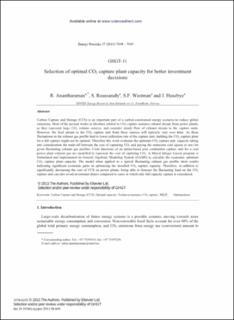| dc.contributor.author | Anantharaman, Rahul | |
| dc.contributor.author | Roussanaly, Simon | |
| dc.contributor.author | Westman, Snorre Foss | |
| dc.contributor.author | Husebye, Jo | |
| dc.date.accessioned | 2020-04-03T06:13:05Z | |
| dc.date.available | 2020-04-03T06:13:05Z | |
| dc.date.created | 2013-09-03T15:47:44Z | |
| dc.date.issued | 2013 | |
| dc.identifier.citation | Energy Procedia. 2013, 37 7039-7045. | en_US |
| dc.identifier.issn | 1876-6102 | |
| dc.identifier.uri | https://hdl.handle.net/11250/2650168 | |
| dc.description.abstract | Carbon Capture and Storage (CCS) is an important part of a carbon-constrained energy scenario to reduce global emissions. Most of the present works in literature related to CO2 capture assumes exhaust stream from power plants, as they represent large CO2 volume sources, and consider steady flow of exhaust stream to the capture units. However, the feed stream to the CO2 capture unit from these sources will typically vary over time. As these fluctuations in the exhaust gas profile lead to lower utilization rate of the capture unit, building the CO2 capture plant for a full capture might not be optimal. Therefore this work evaluates the optimum CO2 capture unit capacity taking into consideration the trade-off between the cost of capturing CO2 and paying the emissions cost (q uota or tax) for given fluctuating exhaust gas profiles. Costs functions of an amine-based post combustion capture unit for a coal power plant exhaust gas are modelled to represent the cost of capturing CO2. A Mixed Integer Lin ear program is formulated and implemented in General Algebraic Modeling System (GAMS) to calculate the econ omic optimum CO2 capture plant capacity. The model when applied to a typical fluctuating exh ust gas profile show results indicating significant economic gains in optimizing the installed CO2 capture capacity. Therefore, in addition to significantly decreasing the cost of CCS on power plants, being able to forecast the fluctuating lo ad on the CO2 capture unit can also avoid investment delays compared to cases in which only full capacity capture is considered. | en_US |
| dc.language.iso | eng | en_US |
| dc.rights | Attribution-NonCommercial-NoDerivatives 4.0 Internasjonal | * |
| dc.rights.uri | http://creativecommons.org/licenses/by-nc-nd/4.0/deed.no | * |
| dc.subject | Carbon Capture and Storage (CCS) | en_US |
| dc.subject | Optimal capacity | en_US |
| dc.subject | Techno-economics | en_US |
| dc.subject | CO2 capture | en_US |
| dc.subject | MILP | en_US |
| dc.subject | Optimization | en_US |
| dc.title | Selection of Optimal CO2 Capture Plant Capacity for Better Investment Decisions | en_US |
| dc.type | Peer reviewed | en_US |
| dc.type | Journal article | en_US |
| dc.description.version | publishedVersion | en_US |
| dc.rights.holder | The Authors | en_US |
| dc.source.pagenumber | 7039-7045 | en_US |
| dc.source.volume | 37 | en_US |
| dc.source.journal | Energy Procedia | en_US |
| dc.identifier.doi | 10.1016/j.egypro.2013.06.640 | |
| dc.identifier.cristin | 1046657 | |
| dc.relation.project | Norges forskningsråd: 193816 | en_US |
| cristin.unitcode | 7548,60,0,0 | |
| cristin.unitname | Gassteknologi | |
| cristin.ispublished | true | |
| cristin.fulltext | original | |
| cristin.qualitycode | 1 | |

